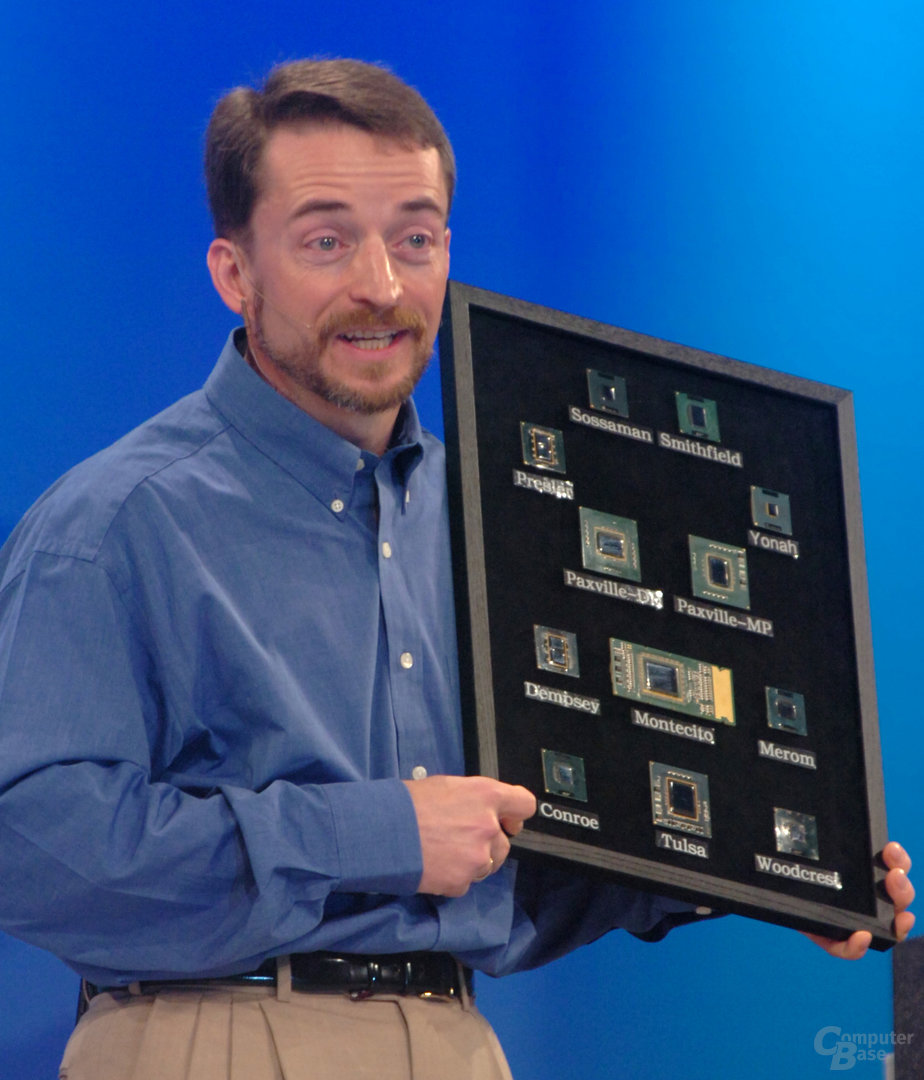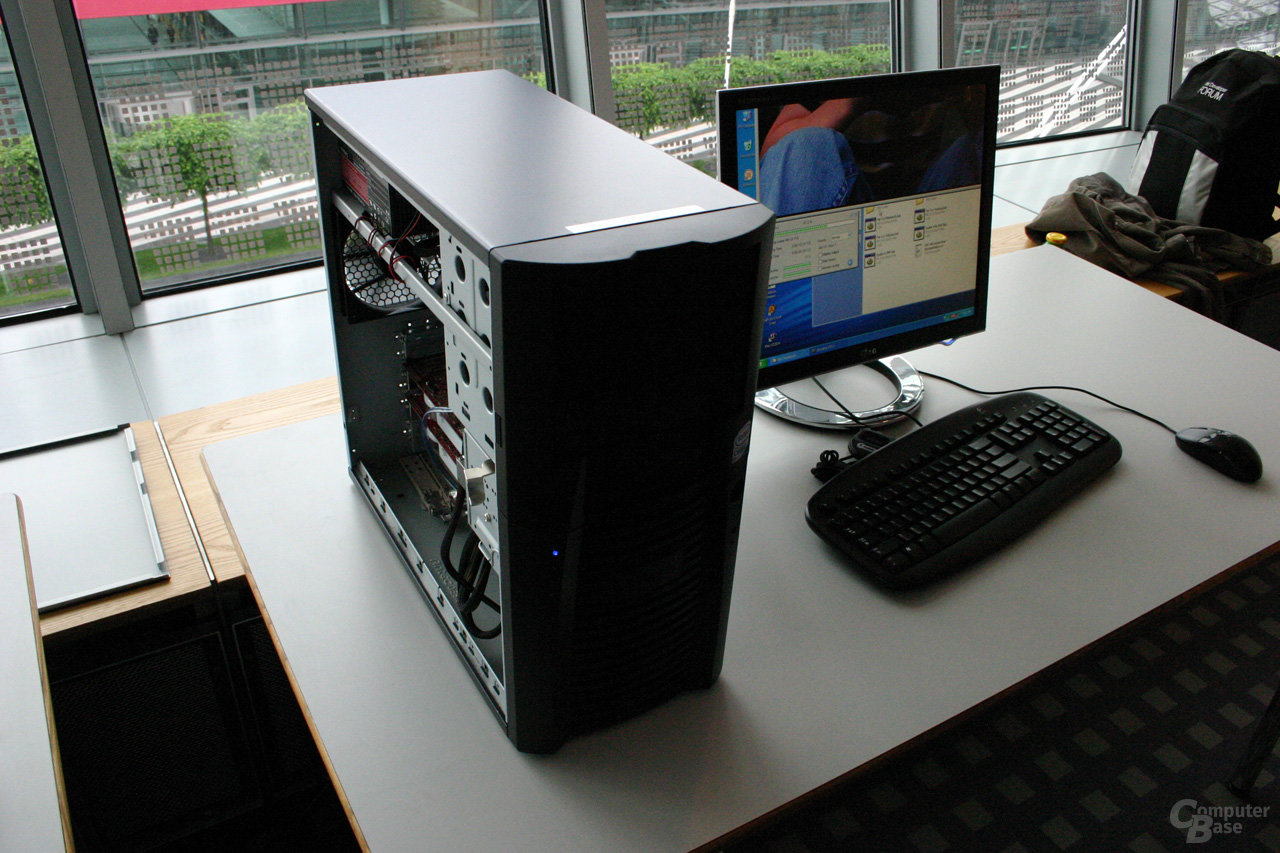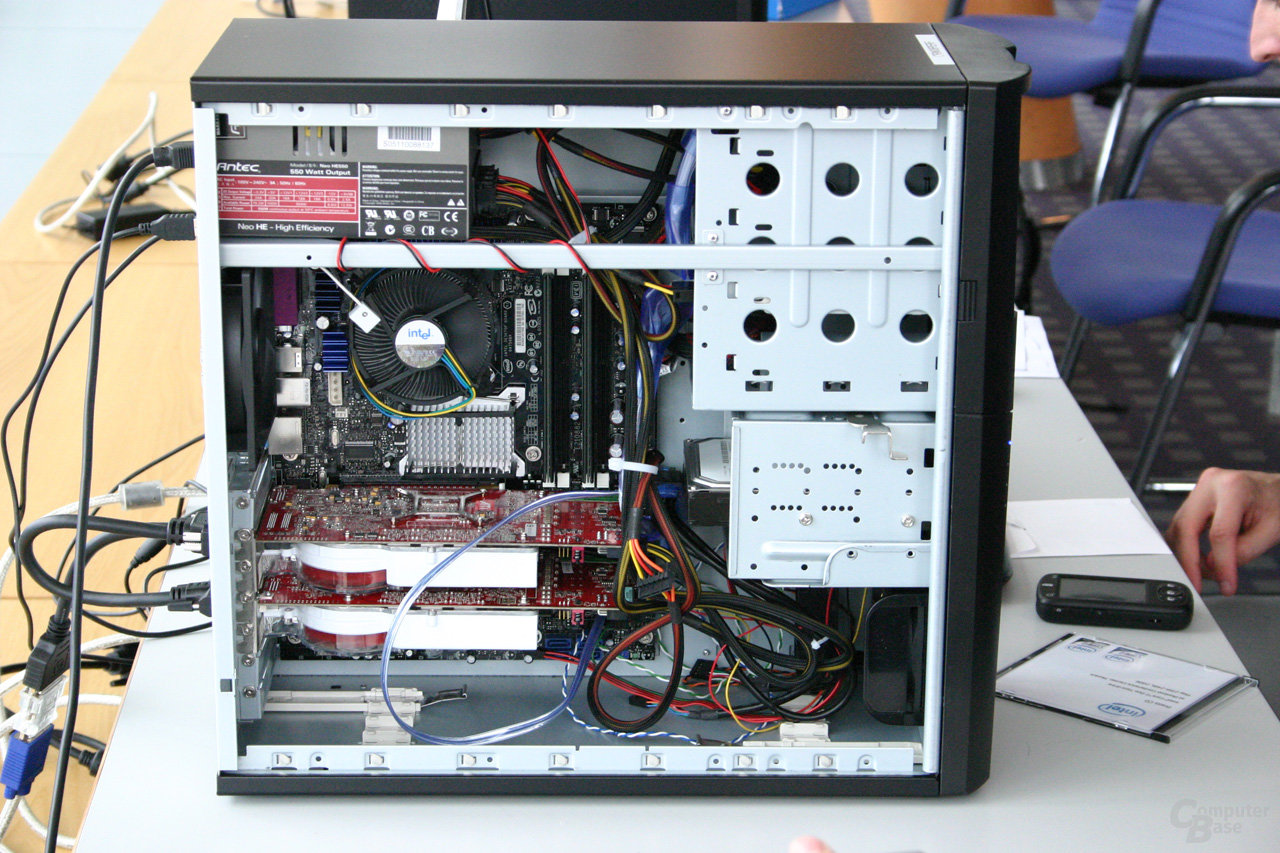After Intel needed more and more clocks for the Pentium 4 due to the inefficient processor architecture to keep up with AMD's Athlon 64 CPUs, the new core architecture should do everything better. The Core 2 Duo E6700 convinced in the preliminary test as one of the first processors with a corresponding architecture.
Table of contents
- 1 Pentium M with a pinch of Pentium 4
- Very fast in the preliminary test
- Conclusion
Pentium M with a pinch of Pentium 4
While Intel was still planning with processors with up to 10 GHz in 2005, disillusionment soon set in due to the high energy requirements and waste heat. Instead, a new CPU architecture based on the energy-saving Pentium M, which was originally developed for notebooks, should bring some improvements to the Pentium 4 with some features. The new goal was to maximize the performance per watt instead of the clock rate.
-
 Pat Gelsinger shows Die at the IDF Spring 2006
Pat Gelsinger shows Die at the IDF Spring 2006
 Pat Gelsinger shows Die at the IDF Spring 2006
Pat Gelsinger shows Die at the IDF Spring 2006  Core 2 Duo E6700 (Conroe) on Intel D975XBX
Core 2 Duo E6700 (Conroe) on Intel D975XBX  Core 2 Duo E6700 (Conroe) on Intel D975XBX
Core 2 Duo E6700 (Conroe) on Intel D975XBX Conroe – the name of the microarchitecture – relied on a drastically shortened pipeline that was only 14 instead of 31 steps long. In addition, the processors were quadruple scalar, so they could execute up to 4 commands per clock cycle. Intel also introduced intelligent power-saving mechanisms that dynamically switch parts of the processor on and off. Conroe was also able to execute SSE, SSE2 and SSE3 commands within one clock cycle – and thus twice as fast as before. All in all, these changes should lead to significantly higher performance per cycle and, at the same time, reduced energy consumption. Intel itself stated about 40 percent more performance with 40 percent lower power consumption.
Very fast in the preliminary test
15 years ago, Intel gave ComputerBase the opportunity to test the Core 2 Duo E6700 in selected software before it was released (today ComputerBase would reject this and insist on its own selection of applications). For this purpose, a system with the 2.66 GHz dual core, an Intel D975XBX mainboard, an ATi Radeon X1900 XTX, and a GByte DDR2-800 with timings of CL4-4-4-12 was put together. To make comparative measurements, ComputerBase used an older revision of the same mainboard, the same graphics card and RAM, but a slower hard drive.
In the benchmarks, the Core 2 Duo E6700 demonstrated how much faster the new architecture worked compared to the old Pentium Extreme Edition 965 (3.73 GHz). In the 3DMark 2006 CPU tests, for example, it was 14 percent faster, in Far Cry there were between 33 and 60 percent more frames per second on average, and in audio encoding in Lame, the E6700 was around 30 percent faster. AMD's Athlon 64 X2 5000+ was also able to beat the Core 2 Duo E6700 in all benchmarks. This was particularly promising considering the price: the Athlon was $ 696 wholesale, while the E6700 was only $ 530.
«Previous PCMark05 TotalPCMark05 CPUPCMark05 GraphicsPCMark05 Memory3DMark06 CPU3DMark06 CPU1 – Red Valley3DMark06 CPU2 – Red Valley3DMark06 CrossFire3DMark06 TotalDivX 6.2.2FarCry ResearchFarCry TrainingFarCry Volcanoame chart =” CarCry TrainingFarCry VolcanoFeari_Tunesb6.0.4Lame 9 “next 3.” class “CaritTunesb7.0.4Loder 9” CariCry TrainingFarCry VolcanoFeari_Tunesb6.0.4Lame 9 li class = “js-chart-carousel-li nojs-block” role = “presentation”> PCMark05 total unit: points
-
- Core 2 Duo E67007.178
- Athlon 64 X2 5000 + 6.154
- Pentium XE 9655.981
- < ul class = "chart__group-body">
- Core 2 Duo E67006.592
- Pentium XE 9656.402
- Athlon 64 X2 5000 + 5.331
-
- Core 2 Duo E67006.888
- Athlon 64 X2 5000 + 6.165
- Pentium XE 9655.980
-
- Core 2 Duo E67005.621
- Athlon 64 X2 5000 + 4.941
- Pentium XE 9654.904
-
- Core 2 Duo E67002.243
- Pentium XE 9651.975
- Athlon 64 X2 5000 + 1.900
-
- Core 2 Duo E67000,719
- Pentium XE 9650,650
- Athlon 64 X2 5000 + 0.606
-
- Core 2 Duo E67001,120
- Pentium XE 9650.959
- Athlon 64 X2 5000 + 0.953
-
- Core 2 Duo E67009.722
- Athlon 64 X2 5000+ 8.077
- Pentium XE 9657.349
-
- Core 2 Duo E67005.901
- Pentium XE 9655.641
- Athlon 64 X2 5000 + 5.603
-
- < li class = "chart__row"> Core 2 Duo E67001: 55
- Pentium XE 9652: 21
- Athlon 64 X2 5000 + 2: 38
- Min:
- Pentium XE 965101,33
- Core 2 Duo E670091,54
- Athlon 64 X2 5000+ 75.63
- Avg:
- Core 2 Duo E6700235.28
- Athlon 64 X2 5000 + 182.17
- Pentium XE 965 159.38
- Max:
- Core 2 Duo E6700265,06
- Athlon 64 X2 5000 +225.62
- Pentium XE 965206.85
- Min:
- Core 2 Duo E670073,66
- Athlon 64 X2 5000 + 66.91
- Pentium XE 96557.90
- Avg:
- Core 2 Duo E6700158,13
- Athlon 64 X2 5000 + 129.56
- Pentium XE 965 118.89
- Max:
- Core 2 Duo E6700284,41
- Pentium XE 965 280.36
- Athlon 64 X2 5000 + 266.62
- Min:
- Core 2 Duo E6700132,44
- Athlon 64 X2 5000 +113.39
- Pentium XE 96574.82
- Avg:
- Core 2 Duo E6700215, 35
- Athlon 64 X2 5000 + 167.91
- Pentium XE 965134.95
- Max:
- Core 2 Duo E6700358,24
- Athlon 64 X2 5000 +307.48
- Pentium XE 965261.87
- Min:
- Core 2 Duo E670053
- Athlon 64 X2 5000 + 0
- Pentium XE 9650
- Avg:
- Core 2 Duo E670098
- Athlon 64 X2 5000 + 0
- Pentium XE 9650
- Max :
- Core 2 Duo E6700225
- Athlon 64 X2 5000 + 0
- Pentium XE 9650
-
- < li class = "chart__row"> Core 2 Duo E67001: 05
- Pentium XE 9651: 14
- Athlon 64 X2 5000 + 1: 17
-
- Core 2 Duo E67002: 52
- Athlon 64 X2 5000 + 3: 35
- Pentium XE 9654: 19
-
- Core 2 Duo E67001: 58
- Pentium XE 9652: 29
- Athlon 64 X2 5000 + 2: 43
-
- Core 2 Duo E67006: 47
- Pentium XE 9658: 41
- Athlon 64 X2 5000 + 9: 11
-
- Core 2 Duo E67001: 06
- Pentium XE 9651: 12
- Athlon 64 X2 5000 + 1: 20
At that time ComputerBase was not allowed to make measurements for power consumption or in programs other than those specified by Intel. The meaningfulness of the results was thus limited, but the tendency clearly showed where the journey with the Conroe architecture would lead.
Conclusion
Compared to the older Pentium Extreme Edition 965, the Core 2 Duo E6700 impressively demonstrated how much faster the new architecture worked despite significantly lower clock rates. Since no comparison measurements were made with AMD's top processors such as the Athlon 64 FX-62 in the preliminary test, it remained to be seen whether Conroe could compete with it. However, it was important to consider that the FX-62 cost over 1,000 euros, while the Core 2 Duo E6700 should be traded for around 530 US dollars. The corresponding competing product was the Core 2 Extreme with 2.93 GHz, which worked even faster.
In the “Tested 15 years ago” category, the editorial team has been looking into the test archive every Saturday since July 2017. The last 20 articles that appeared in this series are listed below:
- Nvidia's nForce 500 for AMD's AM2 socket with DDR2 RAM
- The best Radeon X1900 XTX came with a Zalman cooler
- PCIe x8 versus PCIe x16 for multi-GPU systems
- ATi's X1900 GT bit against Nvidia's 7900 GT Teeth from
- PhysX accelerator for 299 euros from Ageia
- The GeForce 7600 GS was a stunner for 125 euros
- HTPC case from Lian Li and Silverstone
- The GeForce 7900 GTX in 90 nm and with a higher clock rate
- Creative Sound Blaster X-Fi for more audio quality and FPS
- Intel's Pentium EE 965 was faster and more economical
- brought silent winter with RAM-OC the Athlon 64 on tour
- ATi's all-in-wonder Radeons with TV tuner
- Entry-level graphics cards were loud or slow
- Noctuas first CPU cooler NH-U9 and NH-U12
- The GeForce 7800 GS breathed life into AGP again
- ATi's Radeon X1900 XTX was fast, hot and loud
- In the second attempt, ATi CrossFire was better
- The 1st thermal paste made of liquid metal for the PC
- Two GeForce 7800 GTX 512 in the SLI network
< li> Dual-core CPUs from AMD and Intel in a duel
Even more content of this kind and many more reports and anecdotes can be found in d he retro corner in the forum of ComputerBase.


